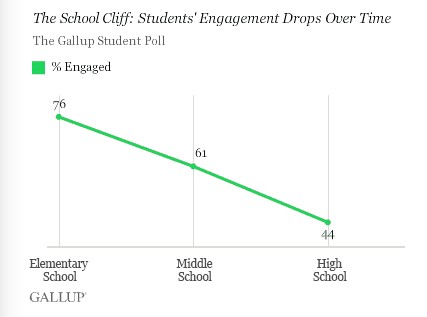No products in the cart.
Posts
Does it Really Matter If Students “Feel” Connected at School?
This is an encore post from June 2017.
In my research for writing “The Power and Promise of Pathways,” I kept stumbling on the term “student engagement.” I was very familiar with some disturbing findings from the Gallup Student Poll that showed how students become increasingly disengaged the further they progress in school. At the elementary school level, 76% of children are engaged with school; at the middle school level, engagement declines to 61%, and by the time a teen is well into the high school experience, their engagement has fallen to just 44 percent! [i] Is it any wonder how hard it is to raise student achievement when fewer than 50 out of every 100 high school students feel connected to their education?

As I looked at multiple resources organized under the umbrella term “engagement,” I came to realize that there are actually three different ways of approaching student engagement. These categories were identified in an analysis of multiple measurement tools that was conducted by Regional Education Lab Southeast. [ii]
The first approach, “Behavioral Engagement,” looks at the things students do that are observable; this includes time on homework, participation in classroom activities, and their extracurricular activities.
A second type of engagement is “Emotional Engagement.” This type of engagement focuses on the student’s internal emotions such as feeling safe and having supportive or positive relationships.
The third type of engagement is “Cognitive Engagement.” This type of engagement involves student self-reflection and self-regulation, sometimes called “meta-cognition.” Meta-cognition is the unique human ability to be aware of and reflect on our own thoughts and emotions. Cognitive engagement also includes a student’s ability to frame questions and solve problems.
Gallup’s Student Poll, administered to over 5 million students since about 2009, focuses on a student’s emotional engagement piece of the equation. The poll asks the student to respond to the following statements:[iii]
- I have a best friend at school.
- I feel safe in this school.
- My teachers make me feel my schoolwork is important.
- At this school, I have the opportunity to do what I do best every day.
- In the last seven days, I have received recognition or praise for doing good schoolwork.
- My school is committed to building the strengths of each student.
- I have at least one teacher who makes me excited about the future.
You can see all the poll questions here.
In first glance, these questions seemed pretty soft and squishy to me. I thought, while it might be nice to enhance a student’s emotional engagement in school, can we really afford to divert from the academic mission of the school? But I discovered that Gallup’s research indicates a strong correlation between students who are “engaged” at the emotional level and their actual academic achievement. For every 1 percentage-point increase in a student’s score on the engagement index, this was associated with a 6-point increase in reading achievement and an 8-point increase in math achievement scores.[iv]
So, think about these questions and how your students might answer them. Do they feel safe? Is anyone explicitly recognizing their hard work, even if they’re a middle achiever? Does every student have a teacher who makes learning personal by connecting it to the student’s sense of their future life?
If you want to move the needle on how students answer these questions, ask yourself which areas involve the whole school culture (the responsibility as the school leader), and which ones are more directly under the control of individual teachers in the classroom?
If you are a school leader or teacher, how can you engage your colleagues in a frank and productive discussion about increasing student’s emotional engagement?
As I read the Gallup questions and think about engagement, it takes me back to my favorite quote about education, one by the poet William Butler Yeats.
“Education is not the filling of a pail, but the lighting of fire.”
In an era of standards and accountability (which I believe are necessary), I applaud your work in returning to the primary mission of education — fanning into flame a person’s natural curiosity and aspiration for a rich, meaningful and productive life. When a student is emotionally connected to learning, then their thinking and their behavior will follow!
[i] http://www.gallup.com/opinion/gallup/170525/school-cliff-student-engagement-drops-school-year.aspx?version=print
[ii] Regional Educational Laboratory Southeast (2011), “Measuring student engagement in upper elementary through high school: a description of 21 instruments,” January 2011, SERVE Center at the University of North Carolina at Greensboro. Retrieved at: https://ies.ed.gov/ncee/edlabs/regions/southeast/pdf/REL_2011098.pdf
[iii] http://www.gallupstudentpoll.com/177182/gallup-student-poll-items-2014.aspx
[iv] Bland, Evie (2014), “More than half of student ‘engaged” in school, says poll,” Education Week, April 16, 2014. Retrieved at http://www.edweek.org/ew/articles/2014/04/09/28gallup.h33.html
Hans Meeder is President of NC3T, the National Center for College and Career Transitions (www.nc3t.com). NC3T provides planning, coaching, technical assistance and tools to help community-based leadership teams plan and implement their college-career pathway systems and strengthen employer connections with education.

